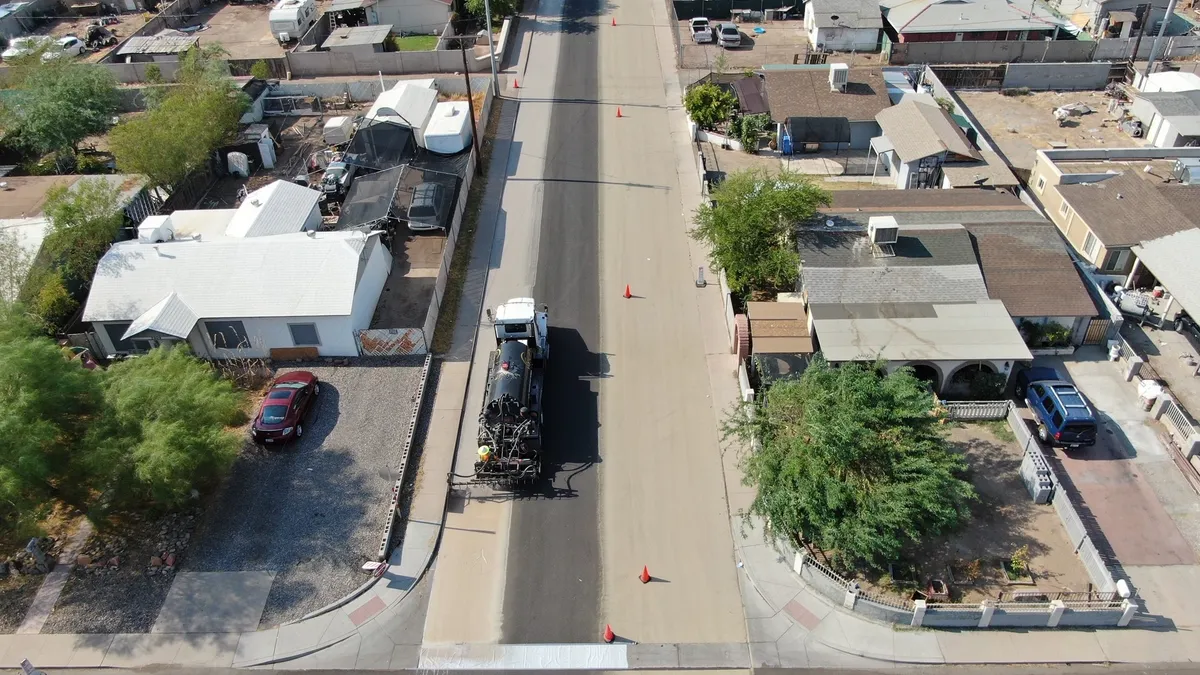Dive Brief:
- While pavements in the city of Phoenix that were treated with cooling technology had significantly lower surface temperatures compared with conventional pavement, the cool pavement also increased the thermal stress a person standing on the surface would experience at midday, according to findings from a study led by Arizona State University in partnership with the city.
- Given this tradeoff, cities should carefully choose locations for implementing cool pavement, which entails applying a coating on top of existing asphalt pavement that reflects rather than retains heat.
- Cool pavement technology is most effective on large parking lots that lack shade or in car-centric cities with hot climates, low cloud cover and wide residential streets, the researchers say. It’s not effective in high-rise downtown areas and shouldn’t be used in areas with high pedestrian traffic like playgrounds, plazas or parks, they add.
Dive Insight:
Amid record-breaking temperatures, more cities are experimenting with cool pavement as a way to minimize the urban heat island effect, which makes cities hotter than outlying areas. Phoenix, which is a national leader in the testing and implementation of cool pavement, says on its website that it is researching whether the material is effective at reducing temperatures in the city’s desert climate.
Among the other notoriously hot cities experimenting with cool pavement are Los Angeles and San Antonio. Researchers in both of those cities also found reductions in surface temperatures in areas with cool pavement.
Reductions in surface temperatures means the pavement is under less thermal strain, which could reduce long-term maintenance needs and costs, the Phoenix researchers say.
However, the research shows that cool pavement may have a much larger impact on the surfaces it’s applied to than the people walking on those surfaces. San Antonio found sites treated with cool pavement had marginally warmer air temperatures on average. The Los Angeles study showed that during a heat wave, a cool pavement-covered neighborhood saw ambient air temperatures as much as 3.5 degrees F cooler than those in an adjacent neighborhood — much less than the double-digit drop in surface temperatures.
Phoenix began its cool pavement program in 2020 and has treated over 107 miles with cool pavement at 27 locations throughout the city, said Ryan Stevens, engineering manager in Phoenix’s street maintenance division, during an Oct. 17 presentation of the study results. In some cases in Phoenix, cool pavement reduced the air temperature in treated areas but only by a very small amount, the researchers found. Cool pavement reduced surface temperatures by up to 12 degrees F during the day, compared with conventional aged pavement.
However, the cool pavement increased the treated areas’ mean radiant temperature — a metric that affects how people perceive the temperature of a space. At noon, the mean radiant temperature in the middle of a Phoenix street with cool pavement was 5.8 degrees F higher than over non-treated asphalt, the researchers found. They conclude that the “moderate” difference is not a large cause for concern, especially if people use the sidewalk rather than the street where the cool pavement is applied.
Experts say these types of results indicate cool pavement is not a solution to rising heat-related illness and death tolls. Indeed, the researchers in Phoenix say that installing cool pavement in areas with high pedestrian traffic could be considered a “maladaptation” in regards to the experience of pedestrians. A maladaptation is an adaptation action that unexpectedly increases a community’s vulnerability to climate change.
“Instead, heat exposure mitigation should focus on shading, such as trees and engineered shade, in these areas,” the study executive summary says. “[Cool pavement] cannot replace the benefits of shade trees for pedestrian cooling.”











